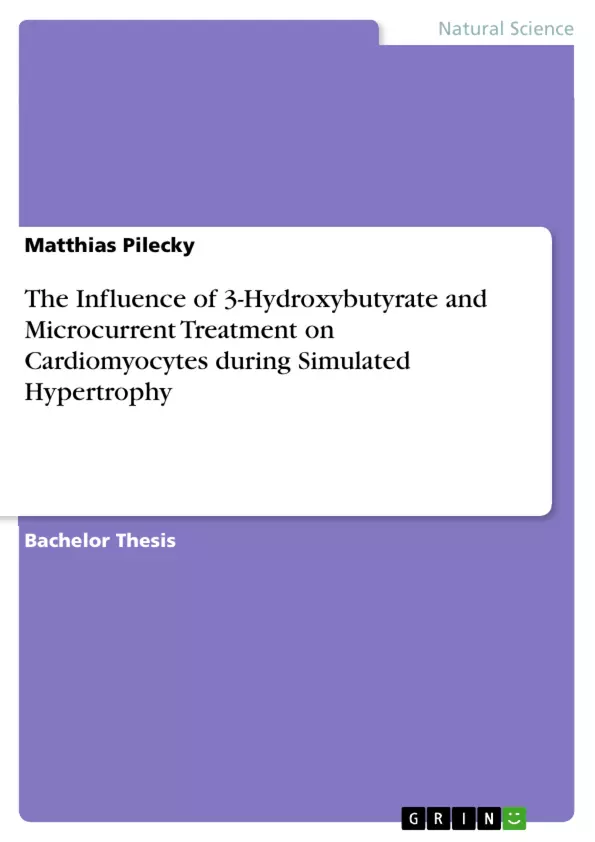Chronic Heart Failure (CHF) is combined with various metabolic shifts. The continuous adrenergic stress results in a metabolic shift increasing glycolysis similar to a fetal metabolism. However also insulin resistance (IR) was reported triggering low glucose uptake
and mitochondrial uncoupling and therefore reactive oxygen species (ROS) production reduce cardiac contractility. The adrenergic increased free fatty acids (FFA) are metabolized to ketone bodies (mainly β-hydroxybutyrate (OHB)) which are also energy stocks for brain and heart. Elevated blood ketone levels have been reported during CHF similar to diabetes. Clinically a correlation between ketone body blood level and severity of CHF has been discovered. However it remains unclear whether this is a result of metabolic changes or a compensatory mechanism. The aim of this study was to show, that rat cardiomyocytes (H9c2) treated with Phenylephrine (PE) for hypertrophy are slightly more susceptible to OHB at concentrations similar found in patients with CHF and that OHB reduces cell area significantly.
Inhaltsverzeichnis (Table of Contents)
- Abstract
- Zusammenfassung
- Introduction
- Theoretical Background
- Chronic Heart Failure
- Mitochondrial Alterations
- Metabolic Shift
- Insulin Resistance
- Ketone Bodies
- Oxidative Stress
- Microcurrent Therapy
- Aim of this experiment
- Results
- Hypertrophic Model
- H9C2
- Primary cardiomyocytes (SHR7)
- Electro Microcurrent treated primary (SHR7) cells
- Cell growth under ẞ-Hydroxybutyrate treatment
- Cell proliferation Assay with alamarBlue®
- Hypertrophic growth under ẞ-Hydroxybutyrate treatment
- ROS assay
- Immunohistochemical staining (Mitochondrial distribution)
- H9c2
- SHR7
- Discussion
- Hypertrophic Model
- Mitochondrial Activity Assay
- ROS Assay
- Immunostaining
- Conclusion
- References
- Eigenständigkeitserklärung
- Attachment
- Abbreviations
- Materials
- Methods
- Hypertrophic Model
- Hypertrophic Measurement
- HE-Staining
- MitoTrackerⓇ
- ROS-Measurement
- OHB Proliferation Assay
- AlamarBlue-Assay
- Cristal Violet-Assay
- Immunostaining (Caveolin-3)
- Immunostaining (a-Tubulin)
- Microcurrent treatment of SHR7 cells
Zielsetzung und Themenschwerpunkte (Objectives and Key Themes)
The study investigates the influence of 3-Hydroxybutyrate (OHB) and microcurrent treatment on cardiomyocytes during simulated hypertrophy. The main objective is to determine the susceptibility of hypertrophic cardiomyocytes to OHB at concentrations observed in patients with Chronic Heart Failure (CHF).- The effects of OHB on cardiomyocyte size and proliferation during simulated hypertrophy
- The role of microcurrent treatment in modulating cardiomyocyte response to OHB
- The interplay between metabolic shifts, insulin resistance, and ketone body production in CHF
- The potential impact of OHB on mitochondrial function and oxidative stress in cardiomyocytes
- The development and application of a hypertrophic model using rat cardiomyocytes (H9c2 and SHR7)
Zusammenfassung der Kapitel (Chapter Summaries)
The "Introduction" section provides an overview of chronic heart failure (CHF) and its associated metabolic alterations, highlighting the role of metabolic shifts, insulin resistance, ketone bodies, and oxidative stress in disease progression. The "Theoretical Background" section delves deeper into these concepts, exploring the impact of mitochondrial alterations, increased free fatty acids, and the role of microcurrent therapy in CHF. The "Results" section presents experimental findings, including the establishment of a hypertrophic model, the effects of OHB on cardiomyocyte size and proliferation, and the role of microcurrent treatment in modulating these effects. The "Discussion" section interprets the results, focusing on the implications for CHF pathology and potential therapeutic interventions.Schlüsselwörter (Keywords)
Chronic Heart Failure, Cardiomyocytes, Hypertrophy, 3-Hydroxybutyrate, Ketone Bodies, Microcurrent Treatment, Insulin Resistance, Mitochondrial Alterations, Oxidative Stress, H9c2, SHR7, Simulated Hypertrophy.- Quote paper
- BSc Matthias Pilecky (Author), 2010, The Influence of 3-Hydroxybutyrate and Microcurrent Treatment on Cardiomyocytes during Simulated Hypertrophy, Munich, GRIN Verlag, https://www.grin.com/document/168718



